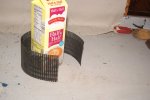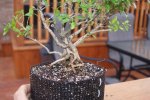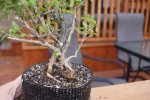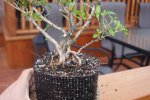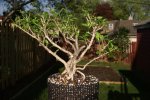Hi there,
Last August I bought a serissa at the MBS meeting:
http://www.bonsainut.com/threads/my-not-so-little-serissa.20183/
It spent it's first winter in IL (it was born and raised in FL) like a charm and yesterday (hence in May following the planing given by @Mellow Mullet ) I did it's re-pot and pruning.
The idea with this tree, based on it's roots, was some sort of negari and I promised @Cadillactaste that I'll post about the process, so there it is.
In fact the negari I was thinking about with this tree wasn't a 'thin columns of roots' like in the drawing Mellow Mullet sent me:
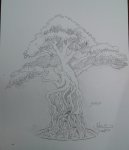
Which seem to me to be like the definition of a negari style.
It was more like a rather short flat cone of roots expanding at the base.
That's the reason why I put a (?) in the title as I don't know if this is a real negari style or not.
Anyway.
My tree, obviously, had the same idea
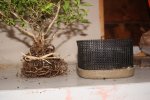
As we could see with its roots yesterday night just before re-poting.
To get a negari as the drawing above I was ready to untangled the roots and pot them in a tube but it was impossible so I went to my original idea of a flat cone.
I flattened the base of the roots to make the cone bigger and potted it in the pot uncle @sorce gave me, obviously for this tree, the very same day I bought the tree, but before
Btw: the roots really smell! (and kinda stink)
So now the idea in order to pursuit the negari style will be to remove the soil little by little as the roots get woody.
The great things with @sorce 's pot is that I could see thru and also I can cut the edge if needed for the negari process.
I did the first step of the process this afternoon by removing the dirt covering the roots already woody.
This is the front face:
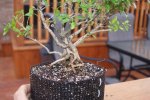
And 2 others:

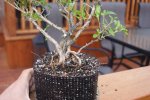
I made a bed of 1/2" of soil at the base for the new roots to colonize and there is also a little space between the rim of roots (at the base) and the edge of the pot.
Just a hair cut with that and here it is now, ready for summer:
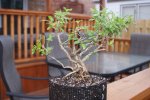
To be continued...

Last August I bought a serissa at the MBS meeting:
http://www.bonsainut.com/threads/my-not-so-little-serissa.20183/
It spent it's first winter in IL (it was born and raised in FL) like a charm and yesterday (hence in May following the planing given by @Mellow Mullet ) I did it's re-pot and pruning.
The idea with this tree, based on it's roots, was some sort of negari and I promised @Cadillactaste that I'll post about the process, so there it is.
In fact the negari I was thinking about with this tree wasn't a 'thin columns of roots' like in the drawing Mellow Mullet sent me:

Which seem to me to be like the definition of a negari style.
It was more like a rather short flat cone of roots expanding at the base.
That's the reason why I put a (?) in the title as I don't know if this is a real negari style or not.
Anyway.
My tree, obviously, had the same idea

As we could see with its roots yesterday night just before re-poting.
To get a negari as the drawing above I was ready to untangled the roots and pot them in a tube but it was impossible so I went to my original idea of a flat cone.
I flattened the base of the roots to make the cone bigger and potted it in the pot uncle @sorce gave me, obviously for this tree, the very same day I bought the tree, but before
Btw: the roots really smell! (and kinda stink)
So now the idea in order to pursuit the negari style will be to remove the soil little by little as the roots get woody.
The great things with @sorce 's pot is that I could see thru and also I can cut the edge if needed for the negari process.
I did the first step of the process this afternoon by removing the dirt covering the roots already woody.
This is the front face:

And 2 others:


I made a bed of 1/2" of soil at the base for the new roots to colonize and there is also a little space between the rim of roots (at the base) and the edge of the pot.
Just a hair cut with that and here it is now, ready for summer:

To be continued...


